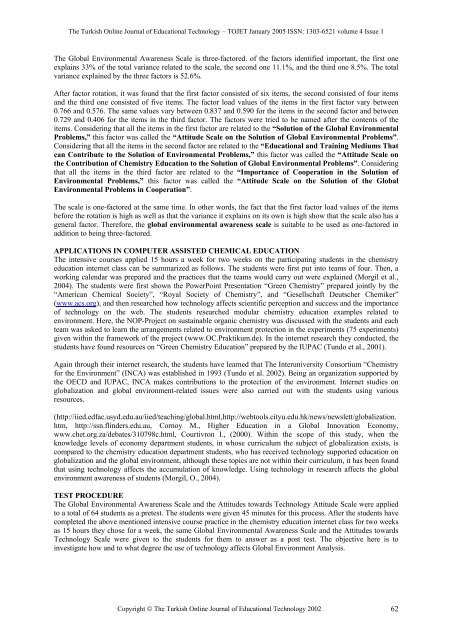Age - TOJET the Turkish online journal of educational technology
Age - TOJET the Turkish online journal of educational technology
Age - TOJET the Turkish online journal of educational technology
Create successful ePaper yourself
Turn your PDF publications into a flip-book with our unique Google optimized e-Paper software.
The <strong>Turkish</strong> Online Journal <strong>of</strong> Educational Technology – <strong>TOJET</strong> January 2005 ISSN: 1303-6521 volume 4 Issue 1<br />
The Global Environmental Awareness Scale is three-factored. <strong>of</strong> <strong>the</strong> factors identified important, <strong>the</strong> first one<br />
explains 33% <strong>of</strong> <strong>the</strong> total variance related to <strong>the</strong> scale, <strong>the</strong> second one 11.1%, and <strong>the</strong> third one 8.5%. The total<br />
variance explained by <strong>the</strong> three factors is 52.6%.<br />
After factor rotation, it was found that <strong>the</strong> first factor consisted <strong>of</strong> six items, <strong>the</strong> second consisted <strong>of</strong> four items<br />
and <strong>the</strong> third one consisted <strong>of</strong> five items. The factor load values <strong>of</strong> <strong>the</strong> items in <strong>the</strong> first factor vary between<br />
0.766 and 0.576. The same values vary between 0.837 and 0.590 for <strong>the</strong> items in <strong>the</strong> second factor and between<br />
0.729 and 0.406 for <strong>the</strong> items in <strong>the</strong> third factor. The factors were tried to be named after <strong>the</strong> contents <strong>of</strong> <strong>the</strong><br />
items. Considering that all <strong>the</strong> items in <strong>the</strong> first factor are related to <strong>the</strong> “Solution <strong>of</strong> <strong>the</strong> Global Environmental<br />
Problems,” this factor was called <strong>the</strong> “Attitude Scale on <strong>the</strong> Solution <strong>of</strong> Global Environmental Problems”.<br />
Considering that all <strong>the</strong> items in <strong>the</strong> second factor are related to <strong>the</strong> “Educational and Training Mediums That<br />
can Contribute to <strong>the</strong> Solution <strong>of</strong> Environmental Problems,” this factor was called <strong>the</strong> “Attitude Scale on<br />
<strong>the</strong> Contribution <strong>of</strong> Chemistry Education to <strong>the</strong> Solution <strong>of</strong> Global Environmental Problems”. Considering<br />
that all <strong>the</strong> items in <strong>the</strong> third factor are related to <strong>the</strong> “Importance <strong>of</strong> Cooperation in <strong>the</strong> Solution <strong>of</strong><br />
Environmental Problems,” this factor was called <strong>the</strong> “Attitude Scale on <strong>the</strong> Solution <strong>of</strong> <strong>the</strong> Global<br />
Environmental Problems in Cooperation”.<br />
The scale is one-factored at <strong>the</strong> same time. In o<strong>the</strong>r words, <strong>the</strong> fact that <strong>the</strong> first factor load values <strong>of</strong> <strong>the</strong> items<br />
before <strong>the</strong> rotation is high as well as that <strong>the</strong> variance it explains on its own is high show that <strong>the</strong> scale also has a<br />
general factor. Therefore, <strong>the</strong> global environmental awareness scale is suitable to be used as one-factored in<br />
addition to being three-factored.<br />
APPLICATIONS IN COMPUTER ASSISTED CHEMICAL EDUCATION<br />
The intensive courses applied 15 hours a week for two weeks on <strong>the</strong> participating students in <strong>the</strong> chemistry<br />
education internet class can be summarized as follows. The students were first put into teams <strong>of</strong> four. Then, a<br />
working calendar was prepared and <strong>the</strong> practices that <strong>the</strong> teams would carry out were explained (Morgil et al.,<br />
2004). The students were first shown <strong>the</strong> PowerPoint Presentation “Green Chemistry” prepared jointly by <strong>the</strong><br />
“American Chemical Society”, “Royal Society <strong>of</strong> Chemistry”, and “Gesellschaft Deutscher Chemiker”<br />
(www.acs.org), and <strong>the</strong>n researched how <strong>technology</strong> affects scientific perception and success and <strong>the</strong> importance<br />
<strong>of</strong> <strong>technology</strong> on <strong>the</strong> web. The students researched modular chemistry education examples related to<br />
environment. Here, <strong>the</strong> NOP-Project on sustainable organic chemistry was discussed with <strong>the</strong> students and each<br />
team was asked to learn <strong>the</strong> arrangements related to environment protection in <strong>the</strong> experiments (75 experiments)<br />
given within <strong>the</strong> framework <strong>of</strong> <strong>the</strong> project (www.OC.Praktikum.de). In <strong>the</strong> internet research <strong>the</strong>y conducted, <strong>the</strong><br />
students have found resources on “Green Chemistry Education” prepared by <strong>the</strong> IUPAC (Tundo et al., 2001).<br />
Again through <strong>the</strong>ir internet research, <strong>the</strong> students have learned that The Interuniversity Consortium “Chemistry<br />
for <strong>the</strong> Environment” (INCA) was established in 1993 (Tundo et al. 2002). Being an organization supported by<br />
<strong>the</strong> OECD and IUPAC, INCA makes contributions to <strong>the</strong> protection <strong>of</strong> <strong>the</strong> environment. Internet studies on<br />
globalization and global environment-related issues were also carried out with <strong>the</strong> students using various<br />
resources.<br />
(http://iied.edfac.usyd.edu.au/iied/teaching/global.html,http://webtools.cityu.edu.hk/news/newslett/globalization.<br />
htm, http://ssn.flinders.edu.au, Cornoy M., Higher Education in a Global Innovation Economy,<br />
www.chet.org.za/debates/310798c.html, Courtivron I., (2000). Within <strong>the</strong> scope <strong>of</strong> this study, when <strong>the</strong><br />
knowledge levels <strong>of</strong> economy department students, in whose curriculum <strong>the</strong> subject <strong>of</strong> globalization exists, is<br />
compared to <strong>the</strong> chemistry education department students, who has received <strong>technology</strong> supported education on<br />
globalization and <strong>the</strong> global environment, although <strong>the</strong>se topics are not within <strong>the</strong>ir curriculum, it has been found<br />
that using <strong>technology</strong> affects <strong>the</strong> accumulation <strong>of</strong> knowledge. Using <strong>technology</strong> in research affects <strong>the</strong> global<br />
environment awareness <strong>of</strong> students (Morgil, O., 2004).<br />
TEST PROCEDURE<br />
The Global Environmental Awareness Scale and <strong>the</strong> Attitudes towards Technology Attitude Scale were applied<br />
to a total <strong>of</strong> 64 students as a pretest. The students were given 45 minutes for this process. After <strong>the</strong> students have<br />
completed <strong>the</strong> above mentioned intensive course practice in <strong>the</strong> chemistry education internet class for two weeks<br />
as 15 hours <strong>the</strong>y chose for a week, <strong>the</strong> same Global Environmental Awareness Scale and <strong>the</strong> Attitudes towards<br />
Technology Scale were given to <strong>the</strong> students for <strong>the</strong>m to answer as a post test. The objective here is to<br />
investigate how and to what degree <strong>the</strong> use <strong>of</strong> <strong>technology</strong> affects Global Environment Analysis.<br />
Copyright © The <strong>Turkish</strong> Online Journal <strong>of</strong> Educational Technology 2002 62
















